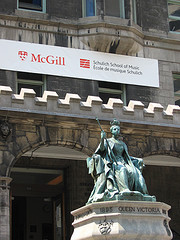Labs of MIR - CIRMMT
 This month I'm featuring photos of the various music information retrieval labs that are the brains behind music 2.0.
This month I'm featuring photos of the various music information retrieval labs that are the brains behind music 2.0.
This week features CIRMMT - the Center for Interdisciplinary research in Music Media and Technology located at McGill University in Montreal Canada.
Ich has sent me this
nice panoramic photo of the lab. Click on it to see the full size
(and very large!) version. There
are lots of nice things to see in this shot. Everyone seems to have
nice dual flat-screen displays, a mix of Apple and PC workstations, lots of natural
light, people working together (except for poor Cory, all by himself in
the corner). It looks like a fun and productive space.
This picture is of the working space - on my tour of CIRMMT last year, Ich showed me a whole lot more - the CIRMMT web page describes the various CIRMMT labs:
- Lab 1 (36 m2): Hemi-Anechoic Lab. Measurements, room acoustics, diffusion, instrument directivity, transducers spatialization, and room perception in listeners.
- Lab 2 (36 m2): Critical Listening Lab. ITU standard room with multichannel and stereo audio, critical listening, evaluation, and technical ear training research.
- Lab 3 (28 m2): Performance and Recording Lab. Recording of individual performers, motion capture measurements of respirology and performer movements, virtual reality applications.
- Lab 4 (23 m2): Audiovisual Editing Lab. Preparation of test materials, PR and demo preparation, content for archiving, viewing/listening space.
- Lab 5 (52 m2): Multimodal Shared Reality Lab. Audio, video, vibration capture and display and presentation, broadband, high-resolution network communication space, ultra-videoconferencing.
- Lab 6 (23 m2): Perceptual Testing Lab. Experimentation on music and sound perception (will also double as an additional audio editing suite).
From the CIRMMT webpage: The CIRMMT community
is interested in interdisciplinary research related to the creation of
music in the composer's or performer's mind, the performance of music,
its recording and/or transmission, and the reception of music by the
listener. It is also interested in the ways in which vision, haptics
and touch interact with music and sound. CIRMMT seeks to develop
innovative approaches to the scientific study of music media and
technology, to promote the application of newer technologies in science
and the creative arts, and to provide an advanced research training
environment.
